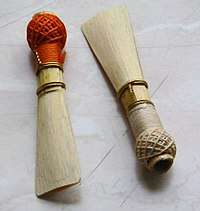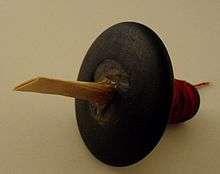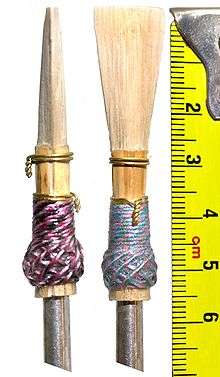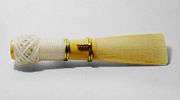Double reed
A double reed is a type of reed used to produce sound in various wind instruments. In contrast with a single reed instrument, where the instrument is played by channeling air against one piece of cane which vibrates against the mouthpiece and creates a sound, a double reed features two pieces of cane vibrating against each other.[1] The term double reeds can also refer collectively to the class of instruments which use double reeds. The timbre of a single and double reed instrument is related to the harmonic series but only including only the odd harmonics due to air column modes canceling out the even harmonics.[2] This may be compared to the timbre of a square wave.[3]
The double reed operates on the same general principle as the single reed. As its name suggests, the double reed consists of two strips of flexible material, bound together at one end around a narrow tube called the staple which is inserted into the playing end of the instrument The reed is placed partly inside the mouth of the payer. When air is blown through the narrow gap between the free ends of the two strips, the reed settles into a vibration pattern in which the gap opens and closes with a frequency close to that of one of the modes of the air column to which it is coupled. As with the single reed, the modulation of the air flow into the instrument contains many harmonic components, each of which will contribute to the strength and timbre or the note to the extent that it finds a matching mode of the air column.
Both double and single reeds are classed as inward-striking reeds, which means that an increase in the blowing pressure tends to narrow the gap through which the air must flow. If the blowing pressure is increased too far, the reed will close completely and the sound will be cut off. This feature sets an upper limit to the amount of sound energy which can be generated using a given reed, although the chanter of the Scottish Highland bagpipe offers pungent that despite this limitation a double reed can still generate a most impressive volume of sound.
— Musical Instruments (2004)[2]


In the double reed the two delicately shaped pieces of reed vibrate against each other, producing the somewhat nasal, reedy tone of the oboe family.[4] In the free reed compressed air is the only buffer which the vibrator encounters while swinging through the aperture, alternately closing and reopening it; hence the soft and mellow timbre which it is possible to produce by proper treatment of the free reed.[4] Experience has shown that the best results for the double reed are obtained when it is used in conjunction with a tube of conical bore, whereas the beating reed is heard to greater advantage in instruments with cylindrical bore, one notable exception in practice being, as already mentioned, the saxophone family.[4] The double reed adapted to a conical tube confers upon the latter the acoustic properties of the open pipe, whose wave-length is equal to that of the tube and which is capable of overblowing the octave and successive harmonics (theoretically).[4] Either a single or a double reed adapted to a cylindrical pipe converts it for all acoustic purposes into a closed pipe, in which the whole wavelength is twice the length of the tube, a node forming at the mouthpiece end.[4] The fundamental note of such a tube will therefore be an octave lower than that of an open pipe of the same length, and it can only overblow the uneven numbers of the harmonic series, such as the third harmonic (or twelfth above the fundamental).[4]
Construction

There are several differences, the most obvious being size, between various types of double reeds, for example between that for a bassoon and that for an oboe or a cor anglais (sometimes called an English horn).
Typically, Arundo donax cane is used for the making of double reeds. For bassoon reeds, tubes of this cane are first split lengthwise then gouged to a certain thickness. The chosen piece of cane is then cut to shape and the centre portion is thinned (profiled). The cane is folded end to end to form the two blades of the reed. The unprofiled end of the cane is shaped into a tube with the aid of a mandrel and bound with three (or four in some reed making techniques) strategically placed wires. A turban made out of thread is added on the third wire. It provides a hand hold for the reed that is not a sharp wire. The folded tip is cut off to allow the blades to vibrate and final adjustments to the interior of the reed using a reamer, and to the exterior using a reed-scraping knife, are carried out. The reed is then ready to fit to the bocal of the bassoon.
The construction of double reeds for the oboe family of instruments is similar in principle: like the bassoon's reeds, they consist of two pieces of Arundo donax cane fastened together with an opening at the tip. However, because the oboe does not have a bocal, the cane must be fastened to a metal tube (the staple), the lower half of which is normally surrounded by a piece of cork. The staple is then inserted into the farrow at the upper end of the oboe.[4]
Players can buy reeds either ready-made, or in various stages of formation, such as part-scraped, reed blanks, or buy the staples and cane separately. Cane is sold in several forms: as tubes, gouged, gouged and shaped, or gouged and shaped and profiled. Bassoon cane has the further option of being profiled before purchase. Cane from several different regions is used in reed making, traditionally from southern France. There are also many options with regard to staples, shaping equipment, and so forth, which all have a subtle effect on the tone quality a reed will produce.
There is a great deal of variation in respect to the construction of reeds; both in terms of the methodology of their creation and in terms of what a finished reed ought to look or sound like, and reedmaking culture varies between countries, cities, and individuals. Oboe reeds are usually about 7 mm (0.3 in) in width, and bassoon double reeds are wider than oboe double reeds with a width anywhere from 13.5–15.9 mm (0.53–0.63 in). The width of a reed affects its sound and response, and so many reed makers variate it to achieve the results they desire. Reed length, which broadly affects pitch, is much less consistent globally, as different orchestras tune to different frequencies. Auxiliary double reeds such as English horn and contrabassoon have their own sets of measurements, which are, again, subject to the requirements of the player.
Differences in reed construction (that may be visually quite minor) can have a substantial impact on the sound produced by the reed, and as a consequence professional double reed players must exercise meticulous craftsmanship in creating a suitable-sounding reed for whatever repertoire they are playing, with yet further considerations such as whether the player is principal or sectional, whether the reed will be suitable for every item on the program, et cetera. Environmental factors such as humidity and temperature also affect the performance of a double reed. Adjustments to reeds are, consequently, very frequent among double reed musicians.
Other reed materials
While cane is by far the most common material for double reeds, it is possible to make reeds from other materials. Reeds made out of synthetic materials may be used; these reeds often last longer and are less sensitive to temperature and humidity fluctuations. Most reeds produced from synthetic materials have a tone quality that is dissimilar to that of a cane reed and are not favored by musicians. However, some recent manufacturers produce synthetic reeds that are used in a professional setting.
Playing a double reed


The orchestral double reeds all employ a similar embouchure. Players pull their lips over their teeth to protect the reed from their teeth, and then excite the blades of the reed by blowing, while controlling the timbre and pitch with constant micromuscular pressure adjustments from the muscles of the mouth and jaw. Articulation is achieved by occluding the mouth of the reed with the tongue and then releasing it, with extended techniques such as double tongue, flutter tongue and growl all possible as on the other woodwind families.
The principal difference between double reed embouchures - both between and within instrument families - is in the positioning of the rolled-in lips, and the musculature employed to control a sound. Oboe reeds, being much longer relative to their width, require concentrated pressure near the tip with more pressure from the sides of the mouth, whereas bassoon reeds are played with lips slightly more pouted and not necessarily aligned vertically. All double reed players employ and develop muscles at the back of the mouth to control their intonation, via adjustments to the shape and pressure of the oral cavity surrounding the reed.
List of instruments which use double reeds
Main Western orchestral instruments
- Bassoon
- Contraforte
- Tenoroon
- Semi contrabassoon
- Contrabassoon (Double bassoon)
- Heckelphone
- Oboe
- Sarrusophone
- Contrabass Sarrusophone
Period instruments
Instruments where the reed is fully enclosed in a windcap
Instruments where the reed is fully exposed
Other instruments
Double reed societies
See also
References
- Petrie, Matthew. "What Type of Reed Does an Oboe Use?". Crook and Staple. Retrieved 14 February 2015.
A double reed has two pieces of cane (Arundo Donax) that are attached to each other and vibrate against each other, when blowen, to create a sound.
- Donald Murray Campbell, Arnold Myers; et. al. (2004). Musical Instruments: History, Technology, and Performance of Instruments of Western Music, p.53-5. Oxford. ISBN 9780198165040.
- Foster, Caxton C. and Soloway, Elliott (1981). Real Time Programming, p.165. Addison-Wesley. ISBN 9780201019377. "One will play a square wave and sound rather like a bagpipe or other double-reed instrument."
-
